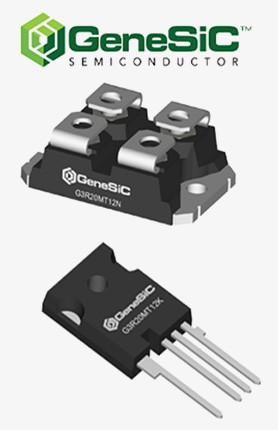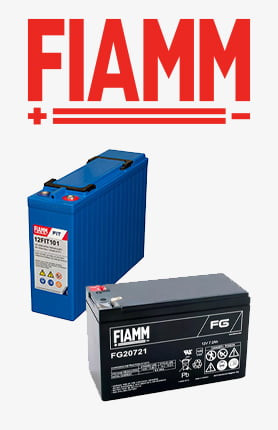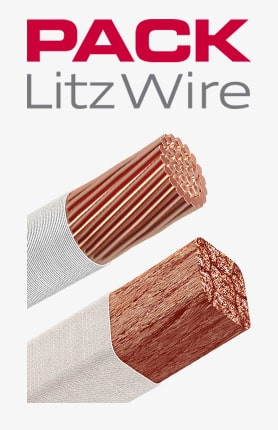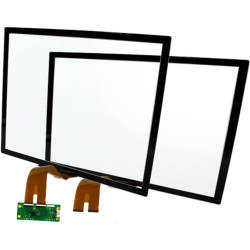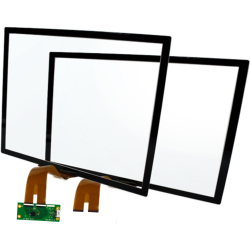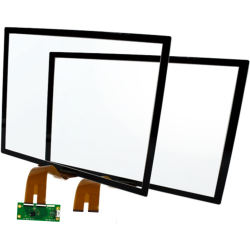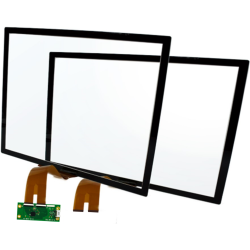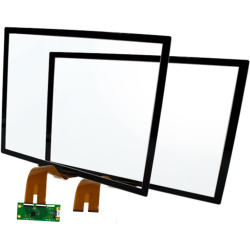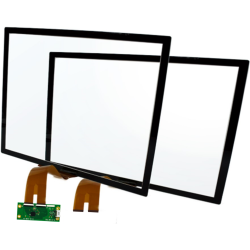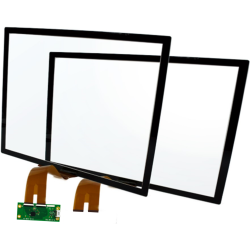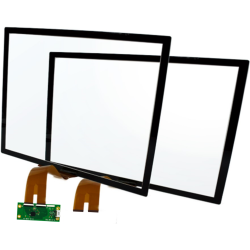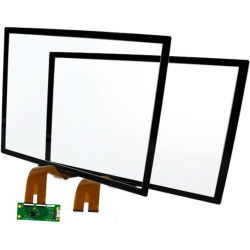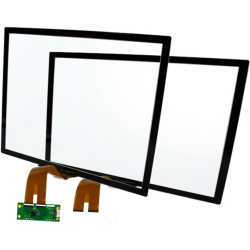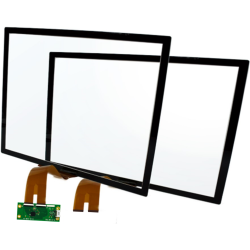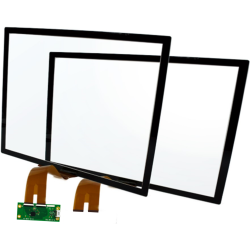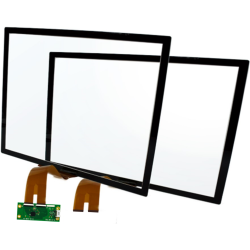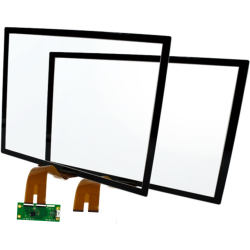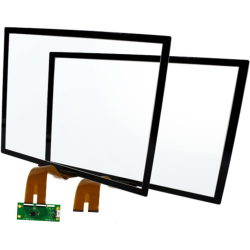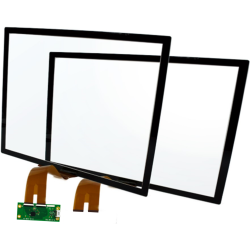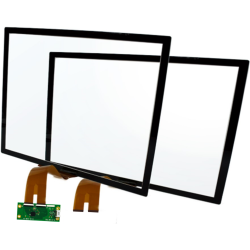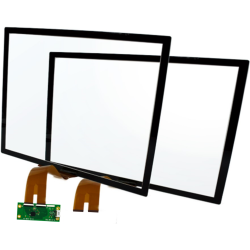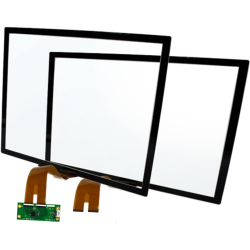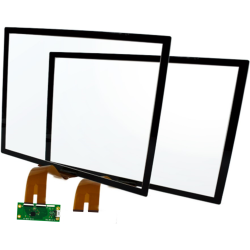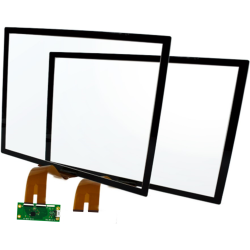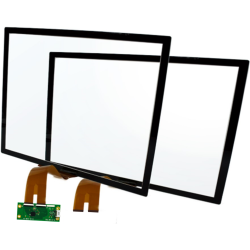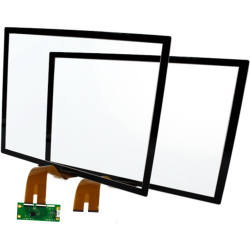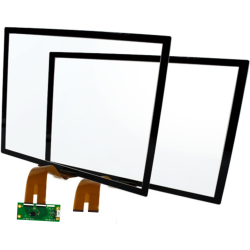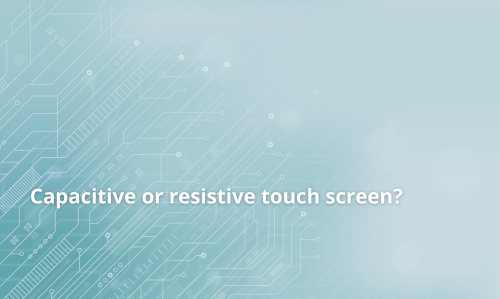Touch screens
Categories
Touch screens have become an integral part of Human-Machine Interface (HMI) systems, enabling intuitive and efficient interaction between humans and machines. Unlike traditional buttons or knobs, a touch screen allows direct control of device functions through touch, gestures, or the use of special tools such as a stylus or protective gloves. This makes the operation of machines, industrial equipment, or information systems faster, more ergonomic, and more flexible.
Touch screen technology has found applications in a wide variety of sectors. In industry, it enables control of production processes, monitoring of machine parameters, and quick response to changes on the production line. In the military sector, touch screens perform well in harsh field conditions and extreme temperatures, allowing reliable control of command systems or mobile equipment. In business and commerce, they are used in points of sale, information kiosks, and reservation systems, where intuitive operation increases customer comfort and staff efficiency.
Modern touch screens, both resistive and capacitive, combine functionality, durability, and resistance to external factors. Their role in HMI continues to grow, and the choice of the right screen technology allows devices to be adapted to specific operational requirements, increasing system efficiency and reliability.
Types of touch screens
The DACPOL offer includes advanced resistive and capacitive (PCAP) touch screens, allowing the selection of appropriate solutions for specific industrial, military, or commercial applications. Each type of screen offers unique features and capabilities worth understanding before choosing the right device.
Resistive screens
Resistive screens operate based on physical pressure, connecting two electrically conductive layers, which allows accurate determination of the touch point. DACPOL’s offer includes, among others:
- Standard 4-, 5-, and 8-wire screens – they differ in the method of voltage measurement and wear resistance. 4-wire are the most basic, 5-wire provide greater durability thanks to the conductive layer placed on a glass surface, while 8-wire are an improved version of 4-wire, with partial enhancement of resistance to intensive use.
- ULTRA Resistive technology – this solution offers increased durability and resistance to extreme conditions. Thanks to the use of borosilicate hardened glass combined with a polyester layer, ULTRA screens can operate in temperatures from -35°C to +70°C, are resistant to moisture, dust, and dirt, and can be operated with gloves or a stylus. The ULTRA technology also ensures longer sensor life and resistance to electromagnetic (EMI/RFI) interference, which is particularly important in military and industrial applications.
Capacitive screens (PCAP)
Capacitive screens operate on the principle of electrical charge conduction through the human body or special tools. This enables precise operation and multi-touch functionality, ideal for modern control systems, kiosks, or interactive user panels.
- Multi-touch advantages – enable gestures such as zooming, swiping, or rotating objects, which increases intuitiveness and user comfort.
- Protective coatings and aesthetics – capacitive screens use special protective glass, such as AG Cover Glass (Anti-Glare) and anti-fingerprint coatings, which minimize fingerprints, ensure better visibility in sunlight, and enhance device aesthetics.
Thanks to the diversity of available technologies, DACPOL enables the selection of touch screens perfectly matched to the working environment, usage intensity, and expectations regarding durability and panel appearance.
Comparison of resistive and capacitive technologies
The choice of a suitable touch screen largely depends on the working environment, type of application, and user requirements. Resistive and capacitive technologies differ in key characteristics that should be considered before making a decision.
Sensitivity and touch registration method
- Resistive screens respond to pressure – touching with a finger, stylus, or glove causes contact between two conductive layers and sends a signal to the controller. This makes them very precise in situations where a specific pressure force is required, but they do not support multi-touch gestures as effectively as capacitive screens.
- Capacitive (PCAP) screens operate based on electrical conductivity – a finger or conductive stylus touch disturbs the electrostatic field, allowing the screen to read the touch point. This enables multi-touch gestures such as swiping, zooming, or rotating images.
Resistance to water, dust, dirt, and electromagnetic interference
- Resistive screens are naturally resistant to EMI and RFI, do not interfere with other devices, and operate reliably near strong electromagnetic fields. ULTRA models are additionally waterproof and resistant to dust and dirt, making them suitable for harsh industrial and military conditions.
- Capacitive screens have limited resistance to water and dirt – raindrops or moisture can cause false readings. However, they are less prone to scratches due to the use of durable protective glass.
Durability and expected lifetime
- Standard resistive screens (4- and 5-wire) have limited durability depending on the conductive materials and touch layer. The use of ULTRA technology significantly extends the lifetime—up to 10 times longer than standard screens—thanks to the borosilicate glass layer, which prevents cracking of the conductive ITO layer.
- Capacitive screens feature high resistance to long-term use and mechanical damage, but their lifetime may be limited in high humidity conditions or direct liquid exposure.
Control options: finger, glove, stylus
- ULTRA resistive screens can be operated by finger, work glove, or stylus, making them versatile in environments that require hand protection or precise control.
- Capacitive PCAP screens respond best to fingers and special conductive styluses; standard gloves may prevent proper operation unless specific glove-touch technologies are applied.
Applications of resistive and capacitive screens
- ULTRA resistive screens are ideal for heavy industry, military, outdoor systems, transport, and retail points under tough conditions – thanks to resistance to shocks, temperature, dust, and water.
- Capacitive PCAP screens dominate in office environments, interactive kiosks, customer service points, and wherever high visual quality, screen responsiveness, and multi-touch functionality are crucial.
Applications of touch screens
Touch screens are used in nearly every industry where human-machine interaction (HMI) is key. Their versatility allows both resistive and capacitive technologies to be adapted to specific user needs depending on the work environment, control method, and durability requirements.
Heavy industry and production
In production plants and heavy industry, ULTRA resistive screens perform well thanks to resistance to dust, water, oils, high temperature, and vibrations. Their robust design allows precise machine and equipment control in harsh environments, where reliability and safety are paramount. Multi-touch in standard resistive screens is limited, but 2-point controllers provide simple operational gestures.
Military and defense applications
In military and defense environments, where resistance to electromagnetic interference (EMI/RFI) is critical, resistive screens prove indispensable. The ability to operate with gloves or a stylus and resistance to extreme weather and mechanical damage make this technology preferred in armored vehicles, command centers, navigation systems, and field control terminals.
Points of sale, kiosks, ATMs, reservation systems
In public spaces such as points of sale (POS), interactive kiosks, ATMs, and reservation systems, both capacitive and resistive screens have their place.
- PCAP screens offer attractive aesthetics, clear display, and multi-touch responsiveness, allowing users to intuitively make purchases, reservations, or payments.
- ULTRA resistive screens provide reliability in challenging conditions – e.g., in locations exposed to moisture, dirt, or heavy public use.
Mobile devices and multimedia
In mobile devices, multimedia systems, and interactive control panels, capacitive screens dominate due to their comfort of use, touch precision, and support for gestures such as pinch, swipe, or rotate. Standard resistive screens may be used in industrial tablets or specialized terminals where environmental resistance is a priority, and multi-touch gestures are not required.
Special features of ULTRA Resistive screens
ULTRA Resistive touch screens are advanced solutions for applications requiring the highest durability and reliability. Unlike standard resistive screens, ULTRA technology was developed for extreme environments and critical applications such as heavy industry, military, or outdoor devices.
Resistance to shocks, vibrations, and extreme temperatures
Thanks to the use of a rigid borosilicate glass layer and reinforced laminate, ULTRA Resistive operates reliably in a wide temperature range: from -35°C to +70°C in operation and from -40°C to +85°C in storage. These screens withstand shocks, vibrations, and contact with rough surfaces, making them ideal for military vehicles, industrial machines, or field equipment.
Resistance to EMI, RFI, and EMP
ULTRA Resistive ensures full resistance to electromagnetic (EMI), radio frequency (RFI), and electromagnetic pulse (EMP) interference. Therefore, this technology can be used in high-interference environments without the risk of touch readout errors, which is especially important in military and control applications.
Extended sensor and ITO layer lifetime
Traditional resistive screens often wear out quickly, especially under frequent stylus use or in high-traffic areas. ULTRA Resistive solves this problem with a stable glass bottom layer that protects conductive ITO coatings from cracking. The result is up to ten times longer lifetime compared to standard resistive screens, with unchanged touch accuracy throughout usage.
Integration capability in underwater and harsh conditions
Exceptional sealing and water resistance allow ULTRA Resistive to be used in underwater or highly humid and dirty environments. Additionally, these screens are resistant to dust, sand, oils, and chemical contaminants, ensuring reliability in any environment – from laboratories and production halls to battlefields and outdoor applications.
Special features of capacitive (PCAP) screens
Capacitive (PCAP) touch screens are a modern solution that combines high precision, attractive appearance, and the ability to support multiple simultaneous touch points. Thanks to these features, they are perfect for interactive systems, points of sale, and modern multimedia applications.
Touch precision and multi-touch support
Capacitive technology responds to changes in the electric field caused by contact with a finger or special stylus. As a result, PCAP screens enable precise control, gesture recognition, and multi-touch operation. This makes them ideal for interactive kiosks, educational systems, and multimedia devices requiring advanced user interaction.
Resistance to mechanical damage and protective coatings
Capacitive screens offered by DACPOL are equipped with durable protective glass, such as AG Cover Glass or anti-fingerprint coating, which enhance scratch resistance, cleanliness, and daily usability. These coatings ensure durability, minimize fingerprints, and improve display clarity, which is especially important in public environments and customer service points.
Applications in aesthetic and interactive solutions
Thanks to elegant design, slim construction, and high responsiveness, PCAP screens are ideal for applications where appearance and interactivity are key. They are used in modern payment terminals, information displays, multimedia panels, and anywhere quick response and attractive presentation of content matter.
A D Metro products available at DACPOL
DACPOL’s offer includes advanced A D Metro touch screens, encompassing both resistive and capacitive (PCAP) technologies. These products stand out for their high-quality design, precision, and suitability for diverse conditions – from industrial to aesthetic multimedia applications.
Resistive screens
In the resistive screen category, special attention should be paid to the ULTRA Resistive series, which offers:
- Increased durability thanks to a stiffer borosilicate glass layer protecting the conductive ITO coating.
- Resistance to extreme conditions – operation in a wide temperature range, vibrations, shocks, humidity, and dust.
- Universal operation – touch by finger, gloves, or stylus.
Example product:
- ULTRA Resistive A D Metro touch screen – resistant to extreme conditions, ideal for military and industrial applications.
- 2-point resistive touch screen controller – compatible with ULTRA screens, enabling dual-touch operation.
Capacitive screens (PCAP)
A D Metro capacitive screens are an excellent choice for applications requiring touch precision, multi-touch, and aesthetic appearance. Key features:
- Multi-touch and high sensitivity – ideal for interactive control panels, kiosks, and information displays.
- Protective coatings and aesthetics – AG Cover Glass and anti-fingerprint coatings ensure durability and user comfort.
- Mechanical resistance – protected surfaces minimize the risk of scratches and damage.
Example products:
- A D Metro Capacitive Touch Screen Part 4A99620 – large 55” screen, 16:9 format, ideal for multimedia and control panels.
- A D Metro Capacitive Touch Screen Part 4A99590 – 19.7”, compact and versatile for business and kiosk applications.
- A D Metro Capacitive Touch Screen Part 4A99561 – 19.3”, with AG Cover Glass coating, resistant to dirt and scratches.
Summary and recommendations for choosing a touch screen
The choice of an appropriate touch screen requires consideration of both the working environment and the application’s specifics. Both resistive and capacitive (PCAP) screens offer unique advantages that should be tailored to user needs.
Technology selection by environment and application
- Industrial and military environments – ULTRA Resistive screens are recommended for their resistance to shocks, vibrations, extreme temperatures, and EMI/RFI. The ability to operate with gloves or stylus enhances functionality in harsh conditions.
- Points of sale, kiosks, and reservation systems – both capacitive and resistive screens perform well here, depending on durability, screen size, and interaction requirements.
- Multimedia applications and mobile devices – PCAP screens with multi-touch functionality and protective coatings (AG Cover Glass, anti-fingerprint) provide comfort, precision, and aesthetic appeal.
Touch screen selection criteria
1. Durability and lifetime – check the material of the touch surface, ITO layer strength, and wear resistance.
2. Resistance to external factors – dust, water, scratches, and electromagnetic interference (EMI/RFI/EMP) significantly affect reliability in specific work environments.
3. Control method – choosing a screen that can be operated with a finger, gloves, or stylus provides maximum versatility.
4. Aesthetics and interactivity – for public or multimedia screens, focus on protective coatings, glass clarity, and multi-touch functionality.
The final choice should balance durability, functionality, and appearance, while being adapted to the specific requirements of the environment in which the screen will operate. A D Metro products offered by DACPOL allow selecting a solution perfectly matched to the user’s needs – from extremely durable ULTRA resistive screens to precise, aesthetic capacitive screens.

